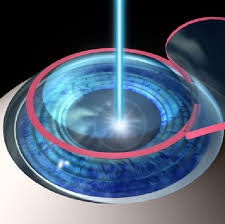855-800-2020Request Information
FREE EXAM - OPEN WEEKENDS
NO INTEREST 0% FINANCING
SAVE 20% to 35% on LASIK*
855-800-2020Request Information
FREE EXAM - OPEN WEEKENDS
NO INTEREST 0% FINANCING
SAVE 20% to 35% on LASIK*
LASEK Eye Surgery (laser epithelial keratomileusis) is a variation on the techniques for PRK and LASIK. Also E-LASIK or just plain LASEK is ideally used for people with corneas that are too thin or too flat for traditional LASIK. LASEK decreases the chance of complications that can occur when creating the corneal flap during traditional microkeratome LASIK when the cornea is not the ideal thickness.
In LASEK, the epithelium, or outer layer of the cornea is removed using finer blade called a trephine instead of the microkeratome used in LASIK. The surgeon then covers the eye with an alcohol solution (perhaps one part alcohol and four parts sterile water) for around 30 seconds. The solution loosens the edges of the epithelium. After removing the alcohol solution from the eye, the surgeon then lifts the edge of the epithelial flap and folds it back similar to LASIK. Then the surgeon uses an excimer laser to reshape the corneal tissue underneath and then the epithelial flap is placed back on the eye.
Then a bandage contact lens is put into the eye to allow the flap edges to heal. As in PRK, the bandage contact lens is worn for about three days. You may feel eye irritation during the first day or two afterward. The patient will need to use eye drops (topical steroid drops) for a few weeks after the LASEK treatment to control healing rate. Typical recovery requires more time to fully return vision, when compared to LASIK. The LASEK recovery period is usually about four to seven days, which is shorter than typical PRK recovery. The vision results of LASEK vs LASIK are very similar results, though LASEK takes more time than traditional LASIK to achieve full visual clarity.
LASEK Eye Surgery has some advantages and disadvantages. Corneal flap complications associated with LASIK are typically avoided and there is less frequency of dry eye. In addition, the surgeon has the ability to treat corneas that are not eligible for the traditional LASIK due to being too thin or too flat. However, the LASEK recovery time is typically longer than LASIK and causes slightly more discomfort.
